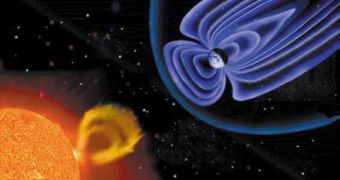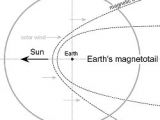Earth's powerful magnetic field is shaped by the solar wind into a tear-like elongated structure, enveloping the planet. This so called magnetotail spans well beyond the orbit of the Moon, meaning that the Moon passes through it once a month, during the full moon phase, determining lunar dust storms and electrostatic discharges on the surface of our natural satellite.
"If the Moon is full, it is inside the magnetotail. The Moon enters the magnetotail three days before it is full and takes about six days to cross and exit on the other side," says Tim Stubbs, University of Maryland scientists and Goddard Space Flight Center investigator.
During this time, the Moon is actually crossing through a stream of electrically charged particles trapped inside the magnetic field of the Earth. Most of these particles, especially electrons, reach the surface, giving it a negative charge. On the dark side of the Moon, the electric charge can build up an electric field of up to several thousand volts, while the illuminated side of the Moon maintains a relatively low and constant electric field due to the action of ultraviolet light which ejects electrons right back into space.
"Proper grounding is strongly recommended," explains Stubbs, because astronomers walking on the surface would get electrically charged as well, and may discharge by simply touching a piece of equipment, which could have undesired consequences especially in the case of very sensitive electronics.
Meanwhile, powerful electrical fields could determine fine particles of moondust to rise high above the surface, creating a temporary dust 'atmosphere' that would dissipate on all the surrounding equipment as night time is over - lunar dust is extremely abrasive. Furthermore, this 'atmosphere' could also experience 'weather', due to uneven charge distribution, which manifests itself through a diaphanous wind phenomenon. Diaphanous wind is especially strong in regions of the Moon dividing the night time from the day.
Because all manned missions were executed in times when the Moon was not in a full-moon phase, nobody is quite certain what would happen when it intersects the Earth's magnetotail. Investigations carried out by the Lunar Prospector between 1998 and 1999 revealed that in the dark side electrical fields may vary between -200 to -1000 volts.
"It is important to note that the plasma sheet - where all the electrons come from - is a very dinamic structure. The plasma sheet is in a constant state of motion, flapping up and down all the time. So as the Moon orbits through the magnetotail, the plasma sheet can sweep across it over and over again. Depending on how dynamic things are, we can encounter the plasma sheet many times during a single pass through the magnetotail with encounters lasting anywhere from minutes to hours or even days," says Jasper Halekas of UC Berkeley.
"As a result, you can imagine how dynamic the charging environment of the Moon is. The Moon can be just sitting there in a quiet region of the magnetotail and then suddenly all this hot plasma goes sweeping by causing the nightside potential to spike to a kilovolt. Then it drops back again just as quickly. [..]That is a very dynamic time for the plasma sheet and we need to study what happens then," continues Halekas.
As NASA plans to return a manned mission to the Moon by 2020, and possibly establish a permanent outpost there, it is very likely that they will study the magnetotail as well.

 14 DAY TRIAL //
14 DAY TRIAL // 
